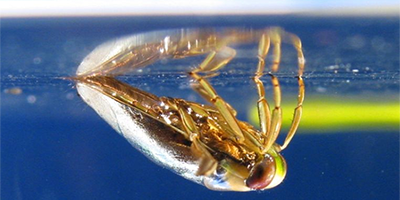Water-Repelling Surfaces Made Stable
Superhydrophobic surfaces, like those on certain water bugs, repel water by trapping air between tiny protrusions. Because the air boundary allows water to flow more easily over the surface, engineers are looking at superhydrophobic coatings as a way to reduce drag in pipes and on boats. However, in most lab tests, the trapped air escapes within an hour. A new study looks at the factors involved in air depletion and demonstrates that a simple superhydrophobic feature can hold onto an air film for days or more when placed at shallow depths.
Superhydrophobicity occurs in the water-repelling leaves of the lotus plant, as well as the air-envelopes used by certain aquatic insects, such as backswimmers. Micro- and nanoscale features on the surface of these organisms create air gaps beneath a water layer. To mimic nature’s superhydrophobicity, researchers have made coatings with hydrophobic particles, carbon nanotubes, and other chunky bits, but trapped air quickly diffuses away when these materials are submerged under water.
Chang-Jin “CJ” Kim and his graduate students at the University of California, Los Angeles, wanted to see if artificial superhydrophobes could be made more stable. They looked at a simple model system consisting of a single micrometer-sized trench placed underwater. Using camera images, the team verified that air in the trench was diffusing out into the water at a rate that depended on the width of the trench, the underwater depth, and the amount of stretching in the membrane (meniscus) at the air-water boundary. The diffusion can stop if the membrane is able to stretch far enough that its surface tension balances the pressure across the boundary. However, the team showed that this equilibrium was only attainable at shallow depths of a few millimeters and under steady temperature and pressure conditions.
This research is published in Physical Review Letters.
–Michael Schirber





